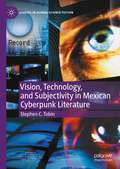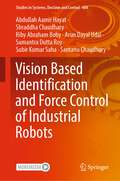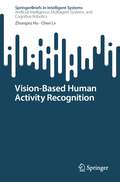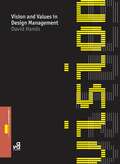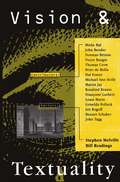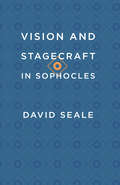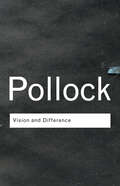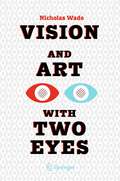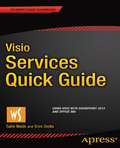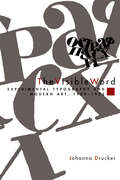- Table View
- List View
Vision, Technology, and Subjectivity in Mexican Cyberpunk Literature (Studies in Global Science Fiction)
by Stephen C. TobinVision, Technology and Subjectivity in Mexican Cyberpunk Literature interrogates an array of cyberpunk and post-cyberpunk science fiction novels and short stories from Mexico whose themes engage directly with visual technologies and the subjectivities they help produce – all published during and influenced by the country’s neoliberal era. This book argues that television, computers, and smartphones and the literary narratives that treat them all correspond to separate-yet-overlapping scopic regimes within the country today. Amidst the shifts occurring in the country’s field of vision during this period, the authors of these cyberpunk and post-cyberpunk narratives imagine how these devices contribute to producing specular subjects—or subjects who are constituted in large measure by their use and interaction with visual technologies. In doing so, they repeatedly recur to the posthuman figure of the cyborg in order to articulate these changes; Stephen C. Tobin therefore contends that the literary cyborg becomes a discursive site for working through the problematics of sight in Mexico during the globalized era. In all, these “specular fictions” represent an exceptional tendency within literary expression—especially within the cyberpunk genre—that grapples with themes and issues regarding the nature of vision being increasingly mediated by technology.
Vision, Sensing and Analytics: Integrative Approaches (Intelligent Systems Reference Library #207)
by Md Atiqur Rahman Ahad Atsushi InoueThis book serves as the first guideline of the integrative approach, optimal for our new and young generations. Recent technology advancements in computer vision, IoT sensors, and analytics open the door to highly impactful innovations and applications as a result of effective and efficient integration of those. Such integration has brought to scientists and engineers a new approach —the integrative approach. This offers far more rapid development and scalable architecting when comparing to the traditional hardcore developmental approach. Featuring biomedical and healthcare challenges including COVID-19, we present a collection of carefully selective cases with significant added- values as a result of integrations, e.g., sensing with AI, analytics with different data sources, and comprehensive monitoring with many different sensors, while sustaining its readability.
Vision Models and Applications to Image and Video Processing
by Christian J. van den Branden LambrechtIn this introduction to vision models and their use in image and video processing applications, prominent authors take on an engineering and signal processing approach. It is intended for an engineering audience that wants to use and become familiar with vision models.
Vision ›Gesamtkunstwerk‹: Performative Interaktion als künstlerische Form (Image #127)
by Alexandra VinzenzSeit Richard Wagner meint der Begriff ›Gesamtkunstwerk‹ die Einheit aller künstlerischen Disziplinen. Im Zuge ganzheitlicher Bestrebungen in der Kunst des 19. und 20. Jahrhunderts nimmt das Konzept, dem die Möglichkeit der Transformation der Gesellschaft zugeschrieben wird, eine zentrale Position ein. Anhand zahlreicher Beispiele, die vom Umkreis der Anthroposophischen Gesellschaft bis zum Bauhaus, von Hermann Nitsch bis Joseph Beuys reichen, zeigt Alexandra Vinzenz, dass die Verbindung von Ästhetik und Politik trotz ihrer visionären Anlage nicht an Reiz verloren hat.
Vision-based Vehicle Guidance (Springer Series in Perception Engineering)
by Ichiro MasakiThere is a growing social interest in developing vision-based vehicle guidance systems for improving traffic safety and efficiency and the environment. Ex amples of vision-based vehicle guidance systems include collision warning systems, steering control systems for tracking painted lane marks, and speed control systems for preventing rear-end collisions. Like other guidance systems for aircraft and trains, these systems are ex pected to increase traffic safety significantly. For example, safety improve ments of aircraft landing processes after the introduction of automatic guidance systems have been reported to be 100 times better than prior to installment. Although the safety of human lives is beyond price, the cost for automatic guidance could be compensated by decreased insurance costs. It is becoming more important to increase traffic safety by decreasing the human driver's load in our society, especially with an increasing population of senior people who continue to drive. The second potential social benefit is the improvement of traffic efficiency by decreasing the spacing between vehicles without sacrificing safety. It is reported, for example, that four times the efficiency is expected if the spacing between cars is controlled automatically at 90 cm with a speed of 100 kmjh compared to today's typical manual driving. Although there are a lot of tech nical, psychological, and social issues to be solved before realizing the high density jhigh-speed traffic systems described here, highly efficient highways are becoming more important because of increasing traffic congestion.
Vision-Based Interaction (Synthesis Lectures on Computer Vision)
by Ahmed ElgammalIn its early years, the field of computer vision was largely motivated by researchers seeking computational models of biological vision and solutions to practical problems in manufacturing, defense, and medicine. For the past two decades or so, there has been an increasing interest in computer vision as an input modality in the context of human-computer interaction. Such vision-based interaction can endow interactive systems with visual capabilities similar to those important to human-human interaction, in order to perceive non-verbal cues and incorporate this information in applications such as interactive gaming, visualization, art installations, intelligent agent interaction, and various kinds of command and control tasks. Enabling this kind of rich, visual and multimodal interaction requires interactive-time solutions to problems such as detecting and recognizing faces and facial expressions, determining a person's direction of gaze and focus of attention, tracking movement of the body, and recognizing various kinds of gestures. In building technologies for vision-based interaction, there are choices to be made as to the range of possible sensors employed (e.g., single camera, stereo rig, depth camera), the precision and granularity of the desired outputs, the mobility of the solution, usability issues, etc. Practical considerations dictate that there is not a one-size-fits-all solution to the variety of interaction scenarios; however, there are principles and methodological approaches common to a wide range of problems in the domain. While new sensors such as the Microsoft Kinect are having a major influence on the research and practice of vision-based interaction in various settings, they are just a starting point for continued progress in the area. In this book, we discuss the landscape of history, opportunities, and challenges in this area of vision-based interaction; we review the state-of-the-art and seminal works in detecting and recognizing the human body and its components; we explore both static and dynamic approaches to "looking at people" vision problems; and we place the computer vision work in the context of other modalities and multimodal applications. Readers should gain a thorough understanding of current and future possibilities of computer vision technologies in the context of human-computer interaction.
Vision Based Identification and Force Control of Industrial Robots (Studies in Systems, Decision and Control #404)
by Abdullah Aamir Hayat Shraddha Chaudhary Riby Abraham Boby Arun Dayal Udai Sumantra Dutta Roy Subir Kumar Saha Santanu ChaudhuryThis book focuses on end-to-end robotic applications using vision and control algorithms, exposing its readers to design innovative solutions towards sensors-guided robotic bin-picking and assembly in an unstructured environment. The use of sensor fusion is demonstrated through a bin-picking task of texture-less cylindrical objects. The system identification techniques are also discussed for obtaining precise kinematic and dynamic parameters of an industrial robot which facilitates the control schemes to perform pick-and-place tasks autonomously without any interference from the user. The uniqueness of this book lies in a judicious balance between theory and technology within the context of industrial application. Therefore, it will be valuable to researchers working in the area of vision- and force control- based robotics, as well as beginners in this inter-disciplinary area, as it deals with the basics and technologically advanced research strategies.
Vision-Based Human Activity Recognition (SpringerBriefs in Intelligent Systems)
by Zhongxu Hu Chen LvThis book offers a systematic, comprehensive, and timely review on V-HAR, and it covers the related tasks, cutting-edge technologies, and applications of V-HAR, especially the deep learning-based approaches. The field of Human Activity Recognition (HAR) has become one of the trendiest research topics due to the availability of various sensors, live streaming of data and the advancement in computer vision, machine learning, etc. HAR can be extensively used in many scenarios, for example, medical diagnosis, video surveillance, public governance, also in human–machine interaction applications. In HAR, various human activities such as walking, running, sitting, sleeping, standing, showering, cooking, driving, abnormal activities, etc., are recognized. The data can be collected from wearable sensors or accelerometer or through video frames or images; among all the sensors, vision-based sensors are now the most widely used sensors due to their low-cost, high-quality, and unintrusive characteristics. Therefore, vision-based human activity recognition (V-HAR) is the most important and commonly used category among all HAR technologies.The addressed topics include hand gestures, head pose, body activity, eye gaze, attention modeling, etc. The latest advancements and the commonly used benchmark are given. Furthermore, this book also discusses the future directions and recommendations for the new researchers.
Vision and Verticality: A Multidisciplinary Approach (Social Visualities)
by Gary Bratchford Dennis ZuevThis rich and accessible volume maps current debates within the expanded field of image-based, vertical analysis. With contributions from astronauts, artists, architects, sociologists, urbanists, visual culture theorists, geographers, anthropologists and more the book signals new moves in inter and multidisciplinary research on visual-vertical thinking and related practices within the social sciences, humanities and across the arts. Grounded in socio-visual thinking, Vision and Verticality addresses the emerging shift in the way social scientists move from a sociology of or through images towards a sociology with images. In doing so, this volume illustrates how the sky and atmosphere remain a surprisingly underexplored domain within visual sociology, beyond the framework of drone-related research. Finally, this volume asserts how vertical and atmospherically framed socio-visual analysis is beginning to shape and inform how we see and experience urban spaces, travel, leisure, politics, and environmental challenges through various prisms, including artistic practices, methodological processes, and user-generated content.
Vision and Values in Design Management (Required Reading Range)
by David HandsVision and Values in Design Management explores the value of design as a key strategic resource that can be utilized in the pursuit of securing a competitive advantage within highly complex and emergent markets. Throughout the book, David Hands offers contributions from key thinkers and practitioners drawn from both industry and academia to provide an essential guide to the development, key issues and future directions of design management.
Vision and Values in Design Management (Required Reading Range)
by Dr David HandsVision and Values in Design Management explores the value of design as a key strategic resource that can be utilized in the pursuit of securing a competitive advantage within highly complex and emergent markets. Throughout the book, David Hands offers contributions from key thinkers and practitioners drawn from both industry and academia to provide an essential guide to the development, key issues and future directions of design management.
Vision and Textuality
This volume brings together the work of distinguished critics and art historians in order to reflect and assess the impact of current critical theory on the discipline and practice of art history. Centring on the intersection of questions of vision with the problematic of textuality, the book addresses how issues of politics, semiotics, psychoanalysis and historiography have contributed to the emergent terms and practices of the new art histories.
Vision and Stagecraft in Sophocles
by David SealeIn this study, David Seale argues that Sophocles’s use of stagecraft, which has thus far received little attention, was as sophisticated as that of Aeschylus or Euripides. His discussions of the physical and visual elements of Sophocles's seven plays center around the theme of sight; he demonstrates that each play is staged to maximize the implications and effects of “seeing” and not “seeing,” of knowledge and ignorance. This emphasis on visual perception, Seale maintains, harmonizes with Sophocles’s use of verbal and thematic techniques to create dramatic movements from delusion to truth, culminating in climaxes that are revelations—moments when things are truly “seen” by both audience and characters.
Vision and Navigation: The Carnegie Mellon Navlab (The Springer International Series in Engineering and Computer Science #93)
by Charles E. ThorpeMobile robots are playing an increasingly important role in our world. Remotely operated vehicles are in everyday use for hazardous tasks such as charting and cleaning up hazardous waste spills, construction work of tunnels and high rise buildings, and underwater inspection of oil drilling platforms in the ocean. A whole host of further applications, however, beckons robots capable of autonomous operation without or with very little intervention of human operators. Such robots of the future will explore distant planets, map the ocean floor, study the flow of pollutants and carbon dioxide through our atmosphere and oceans, work in underground mines, and perform other jobs we cannot even imagine; perhaps even drive our cars and walk our dogs. The biggest technical obstacles to building mobile robots are vision and navigation-enabling a robot to see the world around it, to plan and follow a safe path through its environment, and to execute its tasks. At the Carnegie Mellon Robotics Institute, we are studying those problems both in isolation and by building complete systems. Since 1980, we have developed a series of small indoor mobile robots, some experimental, and others for practical applicationr Our outdoor autonomous mobile robot research started in 1984, navigating through the campus sidewalk network using a small outdoor vehicle called the Terregator. In 1985, with the advent of DARPA's Autonomous Land Vehicle Project, we constructed a computer controlled van with onboard sensors and researchers. In the fall of 1987, we began the development of a six-legged Planetary Rover.
Vision and Displays for Military and Security Applications: The Advanced Deployable Day/Night Simulation Project
by Keith K. NiallRealistic and immersive simulations of land, sea, and sky are requisite to the military use of visual simulation for mission planning. Until recently, the simulation of natural environments has been limited first of all by the pixel resolution of visual displays. Visual simulation of those natural environments has also been limited by the scarcity of detailed and accurate physical descriptions of them. Our aim has been to change all that. To this end, many of us have labored in adjacent fields of psych- ogy, engineering, human factors, and computer science. Our efforts in these areas were occasioned by a single question: how distantly can fast-jet pilots discern the aspect angle of an opposing aircraft, in visual simulation? This question needs some ela- ration: it concerns fast jets, because those simulations involve the representation of high speeds over wide swaths of landscape. It concerns pilots, since they begin their careers with above-average acuity of vision, as a population. And it concerns aspect angle, which is as much as to say that the three-dimensional orientation of an opposing aircraft relative to one’s own, as revealed by motion and solid form. v vi Preface The single question is by no means simple. It demands a criterion for eye-limiting resolution in simulation. That notion is a central one to our study, though much abused in general discussion. The question at hand, as it was posed in the 1990s, has been accompanied by others.
Vision and Difference: Feminism, Femininity and Histories of Art
by Griselda PollockGriselda Pollock provides concrete historical analyses of key moments in the formation of modern culture to reveal the sexual politics at the heart of modernist art. Crucially, she not only explores a feminist re-reading of the works of canonical male Impressionist and Pre-Raphaelite artists including Edgar Degas and Dante Gabriel Rossetti, but also re-inserts into art history their female contemporaries - women artists such as Berthe Morisot and Mary Cassatt. Pollock discusses the work of women artists such as Mary Kelly and Yve Lomax, highlighting the problems of working in a culture where the feminine is still defined as the object of the male gaze. Now published with a new introduction, Vision and Difference is as powerful as ever for all those seeking not only to understand the history of the feminine in art, but also to develop new strategies for representation for the future.
Vision and Difference: Feminism, Femininity and Histories of Art (Routledge Classics Ser.)
by Griselda PollockGriselda Pollock provides concrete historical analyses of key moments in the formation of modern culture to reveal the sexual politics at the heart of modernist art. Crucially, she not only explores a feminist re-reading of the works of canonical male Impressionist and Pre-Raphaelite artists including Edgar Degas and Dante Gabriel Rossetti, but also re-inserts into art history their female contemporaries - women artists such as Berthe Morisot and Mary Cassatt. Pollock discusses the work of women artists such as Mary Kelly and Yve Lomax, highlighting the problems of working in a culture where the feminine is still defined as the object of the male gaze. Now published with a new introduction, Vision and Difference is as powerful as ever for all those seeking not only to understand the history of the feminine in art, but also to develop new strategies for representation for the future.
Vision and Audience in Medieval Drama: A Study of The Castle of Perseverance (The New Middle Ages)
by Andrea Louise YoungThe earliest complete morality play in English, The Castle of Perseverance depicts the culture of medieval East Anglia, a region once known for its production of artistic objects. Discussing the spectator experience of this famed play, Young argues that vision is the organizing principle that informs this play's staging, structure, and narrative.
Vision and Art with Two Eyes (Vision, Illusion and Perception #3)
by Nicholas WadeThis book celebrates binocular vision by presenting illustrations that require two eyes to see the effects of cooperation and competition between them. Pictures are flat but by printing them in different colours and viewing them through similarly coloured filters (included with the book) they are brought to life either in stereoscopic depth or in rivalry with one another. They are called anaglyphs and all those in the book display the ways in which the eyes interact. Thus, the reader is an integral element in the book and not all readers will see the same things. The history, science and art of binocular vision can be experienced in ways that are not usually available to us and with images made specifically for this book. The study of vision with two eyes was transformed by the invention of stereoscopes in the early 19th century. Anaglyphs are simple forms of stereoscopes that have three possible outcomes from viewing them – with each eye alone to see the monocular images, with both eyes to see them in stereoscopic depth or rivalry, or without the red/cyan glasses where they can have an appeal independent of the binocularity they encompass. Through the binocular pictures and the words that accompany them there will be an appreciation of just how remarkable the processes are that yield binocular singleness and depth. Moreover, the opportunities for expressing these processes are explored with many examples of truly binocular art.
Vision Algorithms: International Workshop on Vision Algorithms Corfu, Greece, September 21-22, 1999 Proceedings (Lecture Notes in Computer Science #1883)
by Bill Triggs Andrew Zisserman Richard SzeliskiThis book constitutes the thoroughly refereed post-workshop proceedings of the International Workshop on Vision Algorithms held in Corfu, Greece in September 1999 in conjunction with ICCV'99.The 15 revised full papers presented were carefully reviewed and selected from 65 submissions; each paper is complemented by a brief transcription of the discussion that followed its presentation. Also included are two invited contributions and two expert reviews as well as a panel discussion. The volume spans the whole range of algorithms for geometric vision. The authors and volume editors succeeded in providing added value beyond a mere collection of papers and made the volume a state-of-the-art survey of their field.
Vision 2020
by Ervin LaszloThis revised edition of the classic text of the period provides both the student and the specialist with an informative account of post-Roman English society.
Vision 2020: Reordering Chaos For Global Survival
by Ervin LaszloThis revised edition of the classic text of the period provides both the student and the specialist with an informative account of post-Roman English society.
Visio Services Quick Guide: Using Visio with SharePoint 2013 and Office 365
by Sahil Malik Srini SistlaIn this fast-paced 100-page guide, you’ll learn to load, display and interact with dynamic, data-powered Visio diagrams in SharePoint 2013 or Office 365.Visio Services Quick Guide gives you the tools to build anything from a simple project workflow to an organizational infrastructure diagram, powered by real data from SharePoint or SQL Server. Colleagues can load your diagrams entirely in the browser, meaning that a single Visio client installation is enough to get started. Readers with JavaScript experience will also find out how to get additional control over Visio diagrams using the JavaScript mashup API, and how to build a custom data provider. The final chapter covers some useful information on administering Visio Services.Get started bringing your Visio diagrams to life with the Visio Services Quick Guide.
The Visible Word: Experimental Typography and Modern Art, 1909-1923
by Johanna DruckerEarly in this century, Futurist and Dada artists developed brilliantly innovative uses of typography that blurred the boundaries between visual art and literature. In The Visible Word, Johanna Drucker shows how later art criticism has distorted our understanding of such works. She argues that Futurist, Dadaist, and Cubist artists emphasized materiality as the heart of their experimental approach to both visual and poetic forms of representation; by mid-century, however, the tenets of New Criticism and High Modernism had polarized the visual and the literary. Drucker suggests a methodology closer to the actual practices of the early avant-garde artists, based on a rereading of their critical and theoretical writings. After reviewing theories of signification, the production of meaning, and materiality, she analyzes the work of four poets active in the typographic experimentation of the 1910s and 1920s: Ilia Zdanevich, Filippo Marinetti, Guillaume Apollinaire, and Tristan Tzara. Few studies of avant-garde art and literature in the early twentieth century have acknowledged the degree to which typographic activity furthered debates about the very nature and function of the avant-garde. The Visible Word enriches our understanding of the processes of change in artistic production and reception in the twentieth century.
The Visible, the Sublime and the Sensus Communis: Kant’s Theory of Perception (SpringerBriefs in Philosophy)
by Tamar JaparidzeThis book argues that Kant develops a theory of perception in the Critique of Judgment from which one can redefine his entire project, viewing and using aesthetics as its backbone, from the transcendental aesthetic of the First Critique to the Critique of Taste in the Third. The author shows us how Kant exonerates the role of faculties that account for such judgments linked by inner senses, inclusive of sensus communis. By re-examining the role of the aesthetic within Kant's critical philosophy, the compelling force of the aesthetic turn is revealed in modern philosophy. The text includes Heidegger’s, Hegel’s and Diderot's complex relationship to Kant in this context.This text provides important scholarship for those interested in the Kantian influence on German Idealism, the aesthetic turn in the continental tradition, especially the Frankfurt school, and more generally, those interested in the encounter between philosophy and art in this historical context.
